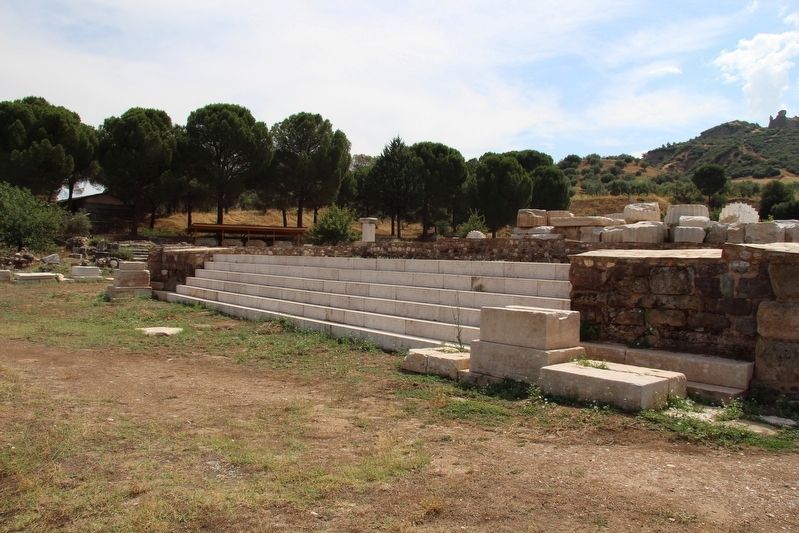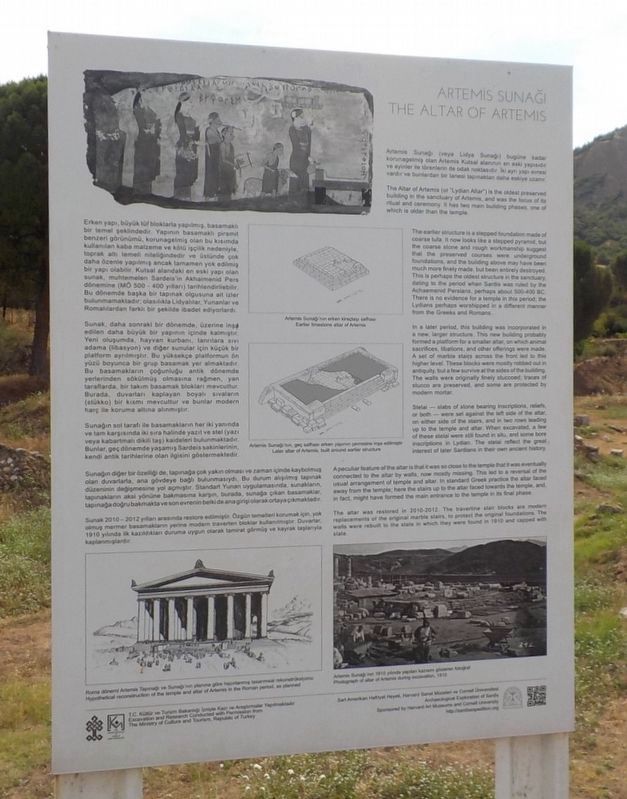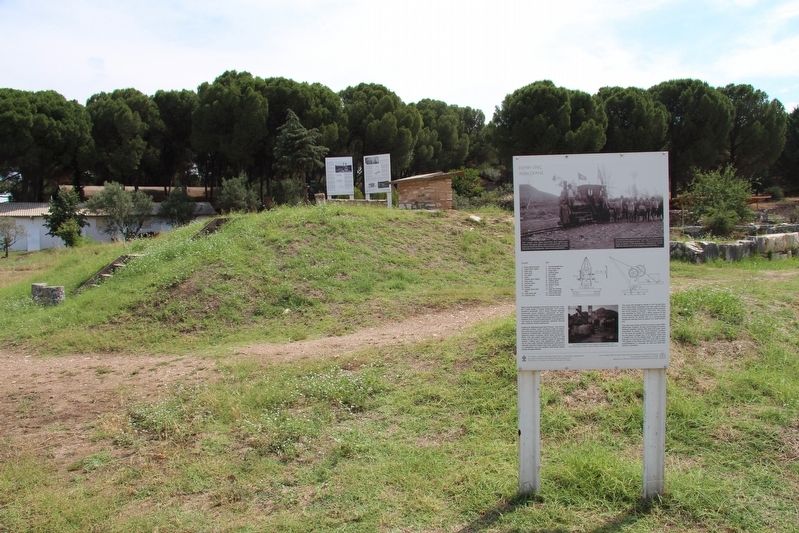Near Sart in Salihli, Manisa, Turkey — West Asia or Southeast Europe
The Altar of Artemis
English Text:
The Altar of Artemis (or "Lydian Altar") is the oldest preserved building in the sanctuary of Artemis, and was the focus of its ritual and ceremony. It has two main building phases, one of which is older than the temple.
The earlier structure is a stepped foundation made of coarse tufa. It now looks like a stepped pyramid, but the coarse stone and rough workmanship suggest that the preserved courses were underground foundations, and the building above, may have been much more finely made, but been entirely destroyed. This is perhaps the oldest structure in the sanctuary, dating to the period when Sardis was ruled by the Achaemenid Persians, perhaps about 500-400 BC. There is no evidence for a temple in this period, the Lydians perhaps worshipped in different manner from the Greeks and Romans.
In a later period, this building was incorporated in a new, larger structure. This new building probably formed a platform for a smaller altar, on which animal sacrifices, libations, and other offerings were made. A set of marble stairs across the front led to this higher level. These blocks were mostly robbed out in antiquity, but a few survive at the sides of the building. The walls were originally finely stuccoed, traces of stucco are preserved, and some are protected by modern mortar.
Stelai - slabs of stone bearing inscriptions, reliefs, or both - were set against the left side of the altar, on either side of the stairs, and in two rows leading up to the temple and altar. When excavated, a few of these stelai were still found in situ, and some bore inscriptions in Lydian. The stelai reflect the great interest of later Sardians in their own ancient history..
A peculiar feature of the altar is that it was so close to the temple that it was eventually connected to the altar by walls, now mostly missing. This led to a reversal of the usual arrangement of temple and altar. In standard Greek practice the altar faced away from the temple; here the stairs up to the altar faced towards the temple, and fact, might have formed the main entrance to the temple in its final phase.
The altar was restored in 2010-2012. The travertine stair blocks are modern replacements of the original marble stairs, to protect the original foundations. The walls were rebuilt to the state in which they were found in 1910 and capped with slate.
Erected by The Ministry of Culture and Tourism, Republic of Turkey, and the Harvard Art Museums and Cornell University.
Topics. This historical marker is listed in these topic lists: Churches & Religion • Parks & Recreational Areas • Settlements & Settlers.
Location.
38° 28.787′ N, 28° 1.825′ E. Marker is near Sart, Manisa, in Salihli. Marker can be reached from Kenan Evren Cd. just east of Sart Yolu, on the right when traveling east. This marker is on the grounds of the Sardis Archaeological Park, near the ruins of the Temple of Artemis, on a small mound, right next to another marker, along a trail that leads to the Temple site. Touch for map. Marker is in this post office area: Sart, Manisa 45370, Turkey. Touch for directions.
Other nearby markers. At least 8 other markers are within walking distance of this marker. Temple of Artemis: History and Ground Plan (here, next to this marker); Iron Crane (a few steps from this marker); Roman Avenue (approx. 1.2 kilometers away); Boya Dükkán / Paint Shop (approx. 1.2 kilometers away); Tuvaletler / Latrines (approx. 1.2 kilometers away); Lokantalar / Restaurants (approx. 1.2 kilometers away); Mesken / Residence (approx. 1.2 kilometers away); (Yakub'un) Boya Dükkáni / (Jacob's) Paint Shop (approx. 1.2 kilometers away). Touch for a list and map of all markers in Sart.

Photographed By Dale K. Benington, June 16, 2018
3. The Altar of Artemis Marker
View of what is being described on the marker when the text states, "The altar was restored in 2010-2012. The travertine stair blocks are modern replacements of the original marble stairs, to protect the original foundations. The walls were rebuilt to the state in which they were found in 1910 and capped with slate."
Credits. This page was last revised on July 4, 2018. It was originally submitted on June 30, 2018, by Dale K. Benington of Toledo, Ohio. This page has been viewed 180 times since then and 9 times this year. Photos: 1, 2, 3. submitted on June 30, 2018, by Dale K. Benington of Toledo, Ohio.

